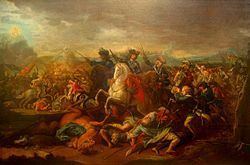100,000 men 30,000 men Result Austrian victory | Dates 16 Jul 1717 – 17 Aug 1717 | |
 | ||
Similar Battle of Petrovaradin, Battle of Zenta, Ottoman–Venetian War, Battle of Chiari, Great Turkish War | ||
The long turkish war 1717 ottoman siege of belgrade
The siege of Belgrade in 1717 occurred during the Austro-Venetian-Ottoman war (1714-1718), after the Austrian victory of Petrovaradin. The siege ended on August 17, 1717 with the conquest of the stronghold by Austrian troops under the command of Prince Eugene of Savoy.
Contents
- The long turkish war 1717 ottoman siege of belgrade
- Prologue
- Preparations
- The final battle
- Consequences
- References
Prologue
After the success of his 1716 campaign, Eugene of Savoy had one main objective: the conquest of the fortress of Belgrade. The city is located exactly at the confluence of the Sava river and the Danube, and its fortress, on an arm of the former river, could be attacked from the south. Its walls could resist both attacks from the south-east and those from the north-west, and this made it a key to the Balkans for both the Austrians and the Ottoman Empire. In 1688, Belgrade was wrested from the Ottomans after a siege, but two years later, the Ottoman Empire recaptured it. Prince Eugene was seriously wounded during the first siege and now strongly supported the need for a river flotilla on the Danube as being essential for the conquest of Belgrade.
The mission of the fleet was to provide assistance and support to the imperial army. Eugene managed to enlist the Emperor's support, and the crew for the ships was hastily recruited in the Netherlands.
The allies of Austria were Russia, which limited itself to a prudent line of defense, and Poland, both still militarily engaged in the Great Northern War against Sweden and Charles XII. Meanwhile, the states of the Holy Roman Empire provided only a modest cash contribution and Bavaria joined the side of Austria.
Preparations
On May 13, 1717 Prince Eugene left Vienna, with his troops from Futtak. Even before the troops were assembled, on May 21, Prince Eugene began his march toward Belgrade with about 70,000 men, reinforced by 6,000 Bavarian and other Austrian troops stationed in the Banat for a total of about 100,000 men. In addition, he commanded the Danube flotilla, consisting of about fifty boats of various types and ten naval vessels armed with light artillery. Eugene wanted to reach the city and begin the siege as soon as possible before any Ottoman troops could reinforce the city. The biggest problem was that the fortress could not be attacked from the south, and progress could only be made after crossing the Danube and the Sava. He chose the direct route, by crossing the Sava river, although, on this side, the fortress offered its strongest side. On the advice of one of his generals, he chose to return across the Danube, surprising the Ottomans who did not expect the enemy to cross the river at that point. The Austrian army managed to cross almost intact between June 15 and 16. Eugene deployed his artillery while the Imperial troops began digging trenches, both in front of the fortress and at the rear of the army. The Ottoman defenders in Belgrade numbered 30,000 men. Prince Eugene was informed that an Ottoman army had been sent to relieve Belgrade. This army arrived on July 28. However, instead of taking action against the besiegers, they also began to dig trenches.
Prince Eugene's troops were caught between the fortress and the relief army. Because of losses to cannon fire as well as malaria, the strength of the Austrian army was slowly diminishing.
The final battle
The Ottomans wanted to let the enemy wear themselves down in a long siege. While the situation was rather worrying for the imperial troops, on August 14, Belgrade was suddenly shaken by a powerful explosion: a mortar shell struck the powder magazine inside the fortress and 3,000 defenders were killed in the explosion. At this time, Eugene ordered an attack on the Ottomans for the next day: at midnight, on August 16, the attack began with infantry in the center and cavalry on the wings. Apart from those men necessary to defend the trenches facing the fortress, the entire army was involved in the attack.
The night attack surprised the Ottomans; after the first hours of fighting, while the sun rose, the Ottomans had predicted an opening in the center of the Austrian attack and attacked in force, before a counterattack by the Austrian cavalry, led by Eugene himself, not only pushed them back but took the trenches, throwing the Ottoman camp into turmoil and causing the soldiers to flee. After 10 hours of fighting, the battle was won by the Austrians. The garrison of Belgrade surrendered after the defeat of the army in exchange for safe passage from the city. Ottoman losses were approximately 20,000 men and a large amount of equipment, ammunition, and artillery.
Consequences
Belgrade fell into the hands of the Austrians, and a year later, the Peace of Passarowitz (July 2, 1718) was signed: Austria obtained at the expense of the Ottoman Empire the Banat, Belgrade, northern Serbia, Wallachia, and other neighboring areas. The Empire reached its maximum expansion in the Balkans. Belgrade remained a territory under the domination of Austria for over twenty years. On July 22, 1739, the Austrian army, commanded by the Field Marshal George Oliver Wallis was defeated near Belgrade, at the Battle of Grocka, by the Ottoman army led by İvaz Mehmet Pasha. As a result of the Treaty of Belgrade (September 1739), the city and all the territories acquired at the Treaty of Passarowitz except Banat were returned to Ottoman rule. (see Capture of Belgrade (1739))
